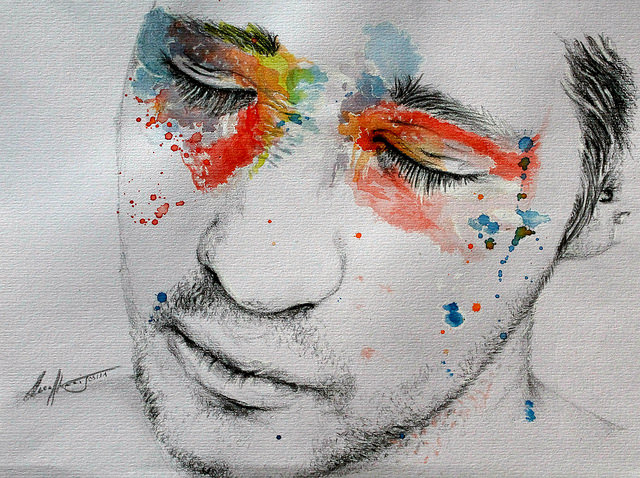Hi World, It’s David. I’m Calling for a collective cry in.
A student, who is also a teacher, recently wrote me an articulate, heartfelt message thanking me for my teachings.
Her words unexpectedly blew me away:
“And I want you to know I am grateful, because I think it’s been a rather confused, uncommunicative, backbiting, retributive, and harsh period within the Ashtanga worldwide community these past months. Lots of negativity, sadness, and fracturing. Too much silence—and not enough celebration of the good, the healing that can happen through the sadhana, the gifts from teacher to student. So, I reach out to let you know I am glad you have been my teacher. That you are a great teacher—earnest, generous, kind, and passionate.”
When I read this a dam broke within me and a monsoon of tears came. The strength of my reaction came as a surprise: one moment I was reading a simple note from a student and the next strong emotions involuntarily welled from my depths and spilled out into heaves of anguish and release.
I experienced waves of sadness, anger, and a sense of hopelessness partly, because of all the pain and strife that has beset our little community.
Also, I sometimes feel that rather than receiving recognition, I have been shunned by the lineage for my unique perspective, even though I have worked passionately for a long time to help Ashtanga yoga grow, evolve, and become the potent personal and collective healing system that it has the potential to become.
At this time, it is more challenging than ever to feel that I can make a positive difference—even though I am pouring all of my energy into trying.
For me crying is both painful and welcome. I don’t cry easily but I wish I could cry like I did more often because there is great healing in accessing such depths of pure emotion. There is not only despair in crying, there is also sweet relief; there is a feeling of being bathed in healing waters and that having a good cry is a great gift of life that leads to renewal.
Like sunlight emerges as clouds clear after a storm, feelings that were previously trapped within me and had no outlet for expression finally flew freely. I felt calmer and more centered even though I spent several unfruitful days pondering the question of how to have an empowering response to the jumble of feelings that have been swirling about within me, and also how to respond positively to the problems that we face in our little Ashtanga world.
After some time, a few insights broke through into my consciousness that have helped me move forward. Now I feel like I can continue to be a positive force for change again.
This is what I concluded:
There are no easy or fast solutions to many of the problems we each face personally as well as collectively. There is often great complexity in the basic matters that we must deal with.
The complexity that is inherent to acting skillfully and responding fittingly to whatever circumstances we face requires us to be patient, caring, and compassionate with ourselves and with each other.
I see two distinct roads we can walk down—each promising a very different future for us as individuals, communities, nations, and collectively as humans. One road leads to more division, bitterness, rancor, resentment, ill feeling, ill will, bad blood, animosity, hostility, enmity, antagonism, irascibility, waspishness, and spleen.
The other road is better. We can walk down it if we take up a practice of constantly remembering the basic and best qualities that define a human being and a yogi. Everyone needs to use their voice to speak out and be heard but at the same time, every single person also has to remember that we are striving for peace and forgiveness, understanding and empathy.
We have a responsibility to listen and include one another’s thoughts and opinions, to lessen pain and suffering wherever possible, to diffuse anger and fear as much as possible, to find reconciliation whenever possible, to speak our truth while having compassion for those who may be suffering too much to be able to hear or accept our truth, to be giving and generous whenever possible, and to seek to find any bit of tolerance when we encounter opposing viewpoints, feelings, or perceptions.
We must each make sure to spend a significant part of our energies in examining ourselves and in reflection seeking to know our own biases, hidden agendas, and selfish desires. We must not only demand that others change but be rigorous and compassionate in holding ourselves accountable for the change that we wish to see in the world. We must be as vigilant in seeing our own biases, fears, mistakes, failures, shortcomings, and flaws as we are in pointing out these qualities in others.
Lastly, here are some thoughts on ahimsa, the foundation of all yoga, that I’d like to share with you. I think it’s important to understand what yogic texts have to say about conflict.
Ahimsa is not passive or complacent. It is not a stance that denies or ignores a wrongdoing. Ahimsa means that when you are wronged you observe the emotions that arise within you instead of impulsively responding to the emotions.
There are circumstances that will cause the fight-or-flight mechanism within you to go on alert. Hormones will surge through you. You’ll want to hit, maim, kill, aggress, or run away.
To practice ahimsa you must remain cool when your blood is boiling, to seek to understand more than to be understood, to listen more than to speak, and to reconcile more than to divide.
You take the view that anger is a powerful force that you need to restrain and when you do respond in anger it is a weapon that you wield very consciously and carefully in every instance.
It is never okay to lash out impulsively even when others hurt you. If someone lashes out at you or hurts you through their suffering, you somehow manage to find empathy for their suffering.
You do not add to your own suffering by lashing out at them. A yogi feels no satisfaction in revenge. You do not feel better or justified when you hurt another person because they have hurt you.
When you hurt another person, for whatever reason, you acknowledge that you have added to your own suffering and to the world’s suffering.
To meet anger with anger, violence with violence, wrong with revenge, is to increase suffering in every instance. To meet violence or aggression with nonviolence, non-harming is the most powerful response available to the human being.
To embrace ahimsa is to embrace the idea that aggression is never a good response to a situation. To be aggressive doesn’t make the situation better and it doesn’t lead you toward resolution and/or whatever outcome you ultimately desire. Ahimsa is a purposeful stance toward violence that contains the best chance of directing energy toward a peaceful resolution.
I’d like to thank the student who affirmed my path and gave me a good cry. In fact, it was so healing I am calling for a collective cry in.
Perhaps, if we could learn to simply cry more easily, more often, alone, and together, our world could become a better, more loving, and yoga filled place.











Read 0 comments and reply